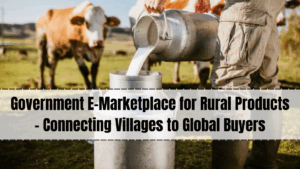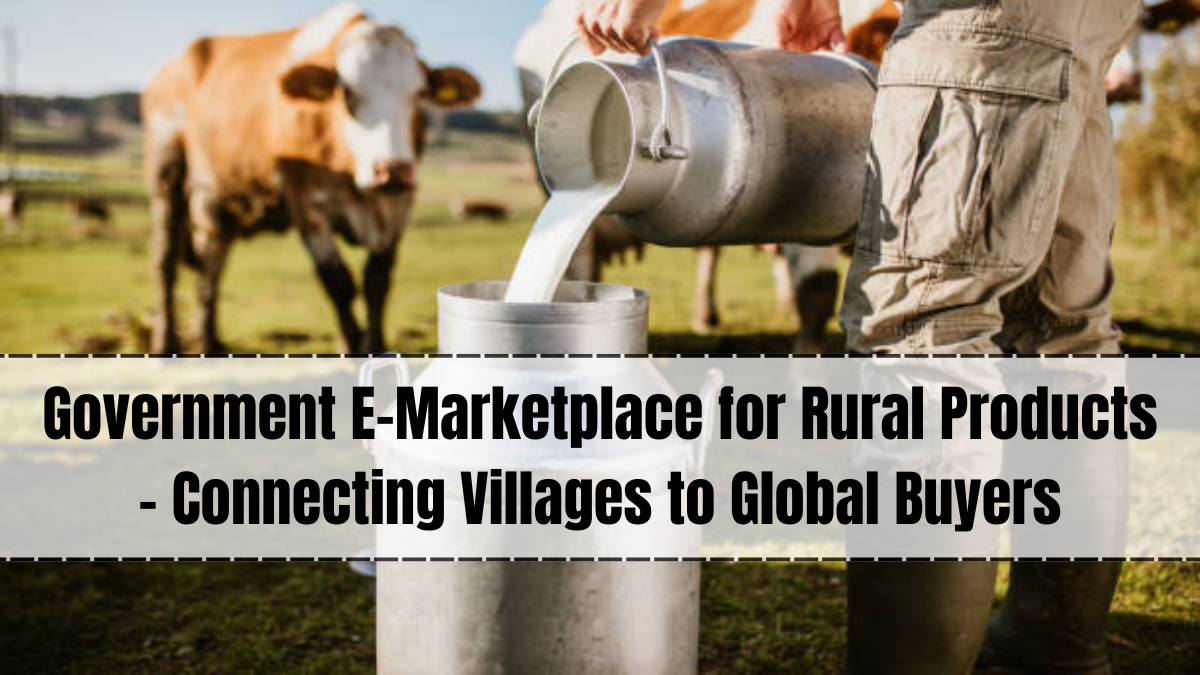In 2025, digital commerce is no longer the exclusive domain of urban sellers and large corporations. With the rise of the Government E-Marketplace (GeM) for Rural Products, village artisans, farmers, and small-scale producers are now finding direct access to buyers across India and even in international markets. This government-backed platform is transforming how rural products are marketed, sold, and delivered, creating new opportunities for rural communities that were once limited to local markets.
For decades, rural producers faced challenges in reaching larger markets. Traditional sales channels often involved middlemen who bought products at low prices and sold them at a much higher margin in urban areas. This reduced the earnings of rural artisans and farmers and limited their ability to expand production or invest in quality improvements. The GeM portal for rural products changes this dynamic by offering a transparent, government-certified platform where sellers can list their goods directly for purchase by individuals, government departments, and institutions.
The concept is simple yet transformative: connect rural producers with buyers without unnecessary intermediaries, while ensuring fair pricing, quality assurance, and timely payments. Whether it is handwoven textiles from a small village in Odisha, organic honey from Himachal Pradesh, or handcrafted bamboo furniture from Assam, the platform brings these products to a national and global audience with just a few clicks.

The Need for a Dedicated Marketplace for Rural Products
Rural India is rich in cultural heritage, natural resources, and traditional skills. However, the absence of a structured marketplace has historically limited the earning potential of rural communities. Common challenges faced by rural producers included:
-
Lack of direct market access to large buyers
-
Low prices due to dependence on intermediaries
-
Poor marketing and branding opportunities
-
Difficulty in ensuring quality consistency for distant buyers
-
Limited payment security in informal transactions
The GeM initiative for rural products directly addresses these problems, enabling rural entrepreneurs to showcase their goods in a standardized, professionally managed online marketplace.
How the Government E-Marketplace Works for Rural Sellers
The process begins with the registration of rural sellers on the GeM portal, which is now simplified to accommodate artisans, self-help groups, cooperatives, and farmer-producer organizations (FPOs). Sellers upload product details, including images, descriptions, and pricing. The platform ensures that products meet quality and compliance standards through certification and verification processes.
Once listed, products become visible to a wide range of buyers, including government procurement agencies, businesses, and individual consumers. Orders can be placed online, and sellers receive payments through secure, government-regulated channels. The marketplace also offers training sessions for rural sellers on topics such as digital marketing, product photography, inventory management, and customer service.
Benefits for Rural Producers
The GeM portal for rural products offers several tangible benefits:
-
Fair Pricing: Without middlemen, sellers can command better prices for their products.
-
Market Expansion: Rural goods can now reach buyers nationwide and globally.
-
Transparency: All transactions are recorded digitally, reducing the risk of disputes.
-
Timely Payments: Government-regulated payment systems ensure faster settlements.
-
Brand Building: Sellers can establish their brand identity and gain repeat customers.
These benefits not only improve the financial well-being of rural producers but also encourage them to innovate, maintain quality standards, and expand their production capacity.
Boosting the Rural Economy and Employment
By providing a direct sales channel, the Government E-Marketplace stimulates the rural economy in multiple ways. Increased demand for rural products leads to higher production, which in turn creates more local jobs. Skilled artisans can train apprentices, farmers can expand cultivation, and women-led self-help groups can diversify their offerings. The steady flow of income helps families invest in education, healthcare, and better living conditions, contributing to overall rural development.
Integration with Logistics and E-Commerce Infrastructure
One of the critical success factors for the GeM portal is its integration with logistics services. The government has partnered with courier companies, India Post, and local delivery startups to ensure that even products from remote villages can be delivered efficiently. Packaging support centers have been set up in some hubs to help rural producers meet shipping standards, while training programs teach sellers how to handle bulk orders.
The marketplace also connects with other government schemes such as ODOP (One District One Product) and PMEGP (Prime Minister’s Employment Generation Programme), ensuring that promoted products receive maximum visibility and marketing support.
Success Stories from Across India
In Uttar Pradesh, women from a self-help group producing organic jaggery reported a 150% increase in sales after listing on the GeM portal. In Rajasthan, hand-embroidered textiles from Barmer are now being purchased by urban boutiques and exported abroad, thanks to direct orders received through the platform. Similarly, tribal artisans from Chhattisgarh are selling traditional Dhokra art to buyers in metro cities and overseas. These success stories prove that when given the right tools and access, rural producers can compete and thrive in larger markets.
Challenges and the Path Forward
Despite its success, there are challenges that need to be addressed for broader adoption. Internet connectivity in remote villages remains inconsistent, which can make online registration and order management difficult. Digital literacy among rural sellers varies, requiring more hands-on training and localized support. Additionally, ensuring consistent quality across large orders is still a learning curve for many small producers.
The future of the Government E-Marketplace for Rural Products lies in scaling up training programs, improving rural internet infrastructure, and strengthening logistics partnerships. As more rural entrepreneurs join the platform, it will become a key driver of inclusive economic growth in India.
FAQs
What is the Government E-Marketplace for rural products?
It is a government-run online platform where rural producers can list and sell their products directly to buyers across India and abroad.
Who can sell on the GeM portal?
Artisans, self-help groups, cooperatives, farmer-producer organizations, and individual rural entrepreneurs can register and sell.
How does it benefit rural sellers?
It provides fair pricing, wider market access, secure payments, and brand-building opportunities.
Is listing on the GeM portal free for rural sellers?
Yes, registration and product listing are free, but sellers must meet quality and compliance standards.
Can rural products be sold internationally through GeM?
Yes, many rural sellers are already exporting through buyers they connect with on the portal.
Click here to know more.
